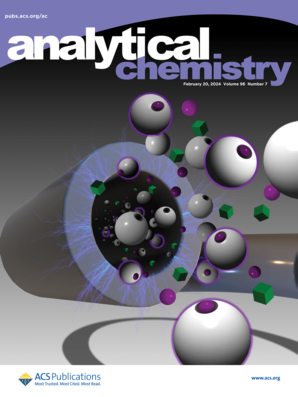Simply Designed and Universal DNA Nanohydrogel for Stimuli-Responsive NIR-II Fluorescence Imaging of Early-Stage Tumor
IF 6.7
1区 化学
Q1 CHEMISTRY, ANALYTICAL
引用次数: 0
Abstract
The delayed detection and recurrence of cancer lead to disappointing cure rates, underscoring the imperative for exploring precise early tumor diagnosis techniques. Despite the superior biocompatibility and flexible programmability of DNA nanoprobes for tumor imaging, intricate designs with multiple oligonucleotide sequences are always indispensable, which significantly hinder their clinical application and commercial development. To construct a simply designed DNA nanoprobe, here, we constructed a universal stimuli-responsive nanohydrogel through the hybridization of the staple strand and skeleton strand. Through a simple substitution of the staple strand, this hydrogel can be adapted for the response to different targets without necessitating a series of subsequent revisions and synthesis optimization. To achieve near-infrared II region (NIR-II) fluorescence imaging, alkynyl-modified NIR-II fluorescent dyes are labeled at two ends of bent staple strands and display weak fluorescence because of the aggregation-caused quenching effect. The highly expressed ATP or cytokine in tumor cells activates the liberation of staples and collapse of the bent configuration, which generates fluorescence recovery for tumor imaging. Moreover, this nanohydrogel also allows for the targeted release of anticancer drugs intercalated in the DNA helix. By integration of NIR-II fluorescent dyes, this versatile nanohydrogel enables precise diagnosis and treatment of early tumors. The straightforward design demonstrates low cost and easy adaptability for multitarget detection, highlighting its significant implications for the advancement of DNA nanotechnology in clinical application and commercialization production.

用于早期肿瘤刺激响应性NIR-II荧光成像的简单设计和通用DNA纳米水凝胶
癌症的延迟发现和复发导致令人失望的治愈率,强调了探索精确的早期肿瘤诊断技术的必要性。尽管用于肿瘤成像的DNA纳米探针具有优越的生物相容性和灵活的可编程性,但复杂的多寡核苷酸序列设计总是必不可少的,这严重阻碍了它们的临床应用和商业发展。为了构建一个简单设计的DNA纳米探针,我们通过短链和骨架链杂交构建了一个通用的刺激响应纳米水凝胶。通过简单的替换短链,这种水凝胶可以适应不同的目标,而不需要后续的一系列修改和合成优化。为了实现近红外II区(NIR-II)荧光成像,烷基基修饰的NIR-II荧光染料被标记在弯曲短纤维链的两端,由于聚集引起的猝灭效应而显示弱荧光。肿瘤细胞中高表达的ATP或细胞因子激活钉状结构的释放和弯曲结构的坍塌,从而产生用于肿瘤成像的荧光恢复。此外,这种纳米水凝胶还允许靶向释放嵌入DNA螺旋中的抗癌药物。通过整合NIR-II荧光染料,这种多功能纳米水凝胶能够精确诊断和治疗早期肿瘤。简单的设计证明了低成本和易于适应多靶点检测,突出了其对DNA纳米技术在临床应用和商业化生产中的重要意义。
本文章由计算机程序翻译,如有差异,请以英文原文为准。
求助全文
约1分钟内获得全文
求助全文
来源期刊

Analytical Chemistry
化学-分析化学
CiteScore
12.10
自引率
12.20%
发文量
1949
审稿时长
1.4 months
期刊介绍:
Analytical Chemistry, a peer-reviewed research journal, focuses on disseminating new and original knowledge across all branches of analytical chemistry. Fundamental articles may explore general principles of chemical measurement science and need not directly address existing or potential analytical methodology. They can be entirely theoretical or report experimental results. Contributions may cover various phases of analytical operations, including sampling, bioanalysis, electrochemistry, mass spectrometry, microscale and nanoscale systems, environmental analysis, separations, spectroscopy, chemical reactions and selectivity, instrumentation, imaging, surface analysis, and data processing. Papers discussing known analytical methods should present a significant, original application of the method, a notable improvement, or results on an important analyte.
 求助内容:
求助内容: 应助结果提醒方式:
应助结果提醒方式:


